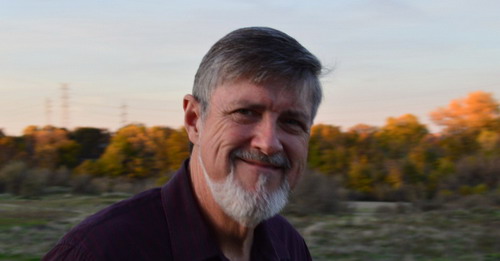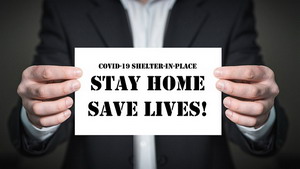 Over the last few weeks, I have seen an increasing number of people presenting with various symptoms derived from stress. The last year has certainly offered plenty of opportunities for developing stress, and I have been surprised at how well folks have been adapting to the lock-down stresses. But as many
polls have been showing lately, people are getting to a breaking point. The lack of supportive human connection on even the most minimal levels has been severely restricted. We don't consciously understand how important non-verbal communication cues are to us, and these are hugely limited by wearing masks over all the facial muscles of communication. On the other end of the spectrum, the tremendous increase in face-to-face online interaction through such mediums as Skype
and Zoom is producing a different kind of stress. We don't normally spend large amounts of time focused just on one person's head, or in Zoom meetings, several heads at once. We get an information overload from this that triggers tension and stress leading to what is being called Zoom fatigue.
Over the last few weeks, I have seen an increasing number of people presenting with various symptoms derived from stress. The last year has certainly offered plenty of opportunities for developing stress, and I have been surprised at how well folks have been adapting to the lock-down stresses. But as many
polls have been showing lately, people are getting to a breaking point. The lack of supportive human connection on even the most minimal levels has been severely restricted. We don't consciously understand how important non-verbal communication cues are to us, and these are hugely limited by wearing masks over all the facial muscles of communication. On the other end of the spectrum, the tremendous increase in face-to-face online interaction through such mediums as Skype
and Zoom is producing a different kind of stress. We don't normally spend large amounts of time focused just on one person's head, or in Zoom meetings, several heads at once. We get an information overload from this that triggers tension and stress leading to what is being called Zoom fatigue.
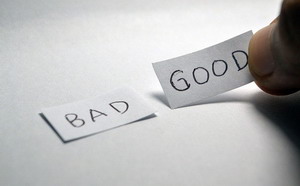 On a larger scale, the constant confrontation with the unknown throws us into fight or flight stress. The messages about covid 19 are so conflicting with “experts” all arguing with each other and their own stories conflicting from day-to-day. Add this in with a highly contentious presidential
election with each side certain that doom will result if the other side wins and you get more stress than our minds are able to bear. The human tendency to class everything as good versus bad and right versus wrong (or in the case of the election right versus left) is a perfect recipe for lots of stress. Bad versus good is a mindset designed to trigger immediate action. “Bad” translates to “survival threat” in our subconscious autonomic brainstem.
It is here in the brainstem that the stress reactions of the body are formed. So, it does not matter how much you might intellectually understand that your immediate survival is not being threatened. The instant you label something as “bad," you have engaged the survival part of your brain and gone into stress.
On a larger scale, the constant confrontation with the unknown throws us into fight or flight stress. The messages about covid 19 are so conflicting with “experts” all arguing with each other and their own stories conflicting from day-to-day. Add this in with a highly contentious presidential
election with each side certain that doom will result if the other side wins and you get more stress than our minds are able to bear. The human tendency to class everything as good versus bad and right versus wrong (or in the case of the election right versus left) is a perfect recipe for lots of stress. Bad versus good is a mindset designed to trigger immediate action. “Bad” translates to “survival threat” in our subconscious autonomic brainstem.
It is here in the brainstem that the stress reactions of the body are formed. So, it does not matter how much you might intellectually understand that your immediate survival is not being threatened. The instant you label something as “bad," you have engaged the survival part of your brain and gone into stress.
 When you hear a baby cry or someone scream out in fear, your body immediately steps into what is called sympathetic excess. Your sympathetic nervous system is your fight or flight system and it operates on adrenaline. It turns you into an action machine, ready to meet whatever crisis is at hand. This
is a good thing for your survival and the survival of the community at large in a natural environment where this type of threat response is needed for only a few minutes at a time, or a few times a week. Adrenaline increases heart rate, opens up the lungs, mobilizes sugar for immediate action in the muscles. If immediate action resolves the issue at hand, everything calms down and life is good. But if the stressful signals continue, the stimulation of the sympathetic nervous
system (SNS) also triggers the release of an inflammatory cytokine called interleukin 6. This inflammatory cytokine can create the feeling of getting the flu, trigger auto-immune disease, depression, ramp up immune function which produces a massive increase of inflammation. Some research even suggests that this cytokine may be a trigger for obesity and diabetes. Some of the newer auto-immune drugs are based on blocking the effect of interleukin 6.
When you hear a baby cry or someone scream out in fear, your body immediately steps into what is called sympathetic excess. Your sympathetic nervous system is your fight or flight system and it operates on adrenaline. It turns you into an action machine, ready to meet whatever crisis is at hand. This
is a good thing for your survival and the survival of the community at large in a natural environment where this type of threat response is needed for only a few minutes at a time, or a few times a week. Adrenaline increases heart rate, opens up the lungs, mobilizes sugar for immediate action in the muscles. If immediate action resolves the issue at hand, everything calms down and life is good. But if the stressful signals continue, the stimulation of the sympathetic nervous
system (SNS) also triggers the release of an inflammatory cytokine called interleukin 6. This inflammatory cytokine can create the feeling of getting the flu, trigger auto-immune disease, depression, ramp up immune function which produces a massive increase of inflammation. Some research even suggests that this cytokine may be a trigger for obesity and diabetes. Some of the newer auto-immune drugs are based on blocking the effect of interleukin 6.
 Enough details, stress tears down your health. Everybody knows this by now. But when I tell people that the answer to their problem is to stop the stress in their life, all I get is a hopeless look from their eyes. How to stop stress? – That is the question. The biggest source of the chronic
stress we deal with day-to-day is not whether we are going to be eaten by a lion, it is our thoughts about life. As Shakespeare wrote in Hamlet “There is nothing either good or bad, but thinking makes it so.” The reality is life is neutral. It does not care about what we think of it. Our negative opinions only serve to make us miserable. In simple terms, most of our stress is not about real survival threats in the now moment, but about what we are
thinking might happen.
Enough details, stress tears down your health. Everybody knows this by now. But when I tell people that the answer to their problem is to stop the stress in their life, all I get is a hopeless look from their eyes. How to stop stress? – That is the question. The biggest source of the chronic
stress we deal with day-to-day is not whether we are going to be eaten by a lion, it is our thoughts about life. As Shakespeare wrote in Hamlet “There is nothing either good or bad, but thinking makes it so.” The reality is life is neutral. It does not care about what we think of it. Our negative opinions only serve to make us miserable. In simple terms, most of our stress is not about real survival threats in the now moment, but about what we are
thinking might happen.
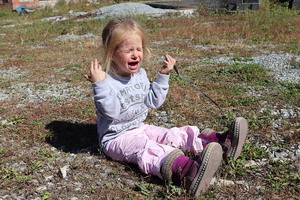 The anti-stress tool I am describing here is what I call Expectation Management. We carry utterly unrealistic expectations about life. We actually believe that things should be our way. This is a holdover from when we were an infant and carried the stress management belief that we were the center of
the universe. Considering how helpless we are at that age, if we had to embrace the truth of our true insignificance in the world, we would totally freak out. So, we create the fiction that we are the most important creation in the world so we can feel assured that we will be taken care of. People have a hard time letting go of this fiction as they get older. Trying to maintain this fiction becomes a constant source of stress for them/us. We just can't accept
that other people don't see things the way we do, don't care about doing things our way, and generally think their own lives are more important than ours. As we get deluged with this message from all sides, we start to expect the worst from life. We see life as good when we are getting our way and life is bad when we are not getting our way. These are the thoughts Shakespeare was referring to in Hamlet.
The anti-stress tool I am describing here is what I call Expectation Management. We carry utterly unrealistic expectations about life. We actually believe that things should be our way. This is a holdover from when we were an infant and carried the stress management belief that we were the center of
the universe. Considering how helpless we are at that age, if we had to embrace the truth of our true insignificance in the world, we would totally freak out. So, we create the fiction that we are the most important creation in the world so we can feel assured that we will be taken care of. People have a hard time letting go of this fiction as they get older. Trying to maintain this fiction becomes a constant source of stress for them/us. We just can't accept
that other people don't see things the way we do, don't care about doing things our way, and generally think their own lives are more important than ours. As we get deluged with this message from all sides, we start to expect the worst from life. We see life as good when we are getting our way and life is bad when we are not getting our way. These are the thoughts Shakespeare was referring to in Hamlet.
 Expectation Management has us embrace that no human is the center of the universe, and each of us is responsible for creating what we want for ourselves to the best of our ability. There is no expectation that life is anything other than neutral – neither for nor against us. However, life is a
constant reflection back to us about how well we are creating what we want. If our skills are crappy, then our life will reflect unfortunate outcomes as a result. Once these simple understandings are fully grasped, then we let go of unrealistic expectations that will never be met. Life is neither good nor bad. It just is what it is. We may like what it is showing us about how well we are creating what we want or we may hate that it is showing us that we are
failing. But life is neutral.
Expectation Management has us embrace that no human is the center of the universe, and each of us is responsible for creating what we want for ourselves to the best of our ability. There is no expectation that life is anything other than neutral – neither for nor against us. However, life is a
constant reflection back to us about how well we are creating what we want. If our skills are crappy, then our life will reflect unfortunate outcomes as a result. Once these simple understandings are fully grasped, then we let go of unrealistic expectations that will never be met. Life is neither good nor bad. It just is what it is. We may like what it is showing us about how well we are creating what we want or we may hate that it is showing us that we are
failing. But life is neutral.
 Acute stress is a different story. Accidents happen, emergencies happen, immediate action is required at times. But those times are generally very rare in the average person's life. Stress diseases are a serious problem in high survival stress situations like soldiers in a war zone. PTSD is
at epidemic proportions as a consequence of situations like these. Unfortunately, to a person who believes that they should get their way, be most important, and special, life is like a war zone for them. They spend every minute trying to defend their personal viewpoint and demand that other people put them first. Living life from the immature fiction of the infant is super stressful because life really does not care that you exist. Your relevance to life only exists in
what you can contribute to life; in how you support life. If you are not contributing value to life, you are invisible.
Acute stress is a different story. Accidents happen, emergencies happen, immediate action is required at times. But those times are generally very rare in the average person's life. Stress diseases are a serious problem in high survival stress situations like soldiers in a war zone. PTSD is
at epidemic proportions as a consequence of situations like these. Unfortunately, to a person who believes that they should get their way, be most important, and special, life is like a war zone for them. They spend every minute trying to defend their personal viewpoint and demand that other people put them first. Living life from the immature fiction of the infant is super stressful because life really does not care that you exist. Your relevance to life only exists in
what you can contribute to life; in how you support life. If you are not contributing value to life, you are invisible.
 Another approach to living a stress-free life is learning to be in the present moment. “Be here now” is the iconic line that describes this approach. This takes Expectation Management to its logical conclusion – stop expecting anything. Stop focusing your attention on the future and
keep it on the here and now. Here and now is the only place where you can make any change and apply any effort towards creating what you want. This does not mean that you don't use conjecture in the here and now to anticipate future needs, but it does mean that you embrace the future as the playground in which you act to create what you want. You don't waste any attention or energy worrying that you may not get your way. Of course you are not going to get your
way. That is not how life works – get over it. Life is a give-and-take in which you use your service and other contributions of value to negotiate the support you need in your own creation process. At best, you can only get as much as you give, so “getting your way” is not even on the table. You can't “win” at the game of life because everything exists in balance, but you can create to your heart's delight.
Another approach to living a stress-free life is learning to be in the present moment. “Be here now” is the iconic line that describes this approach. This takes Expectation Management to its logical conclusion – stop expecting anything. Stop focusing your attention on the future and
keep it on the here and now. Here and now is the only place where you can make any change and apply any effort towards creating what you want. This does not mean that you don't use conjecture in the here and now to anticipate future needs, but it does mean that you embrace the future as the playground in which you act to create what you want. You don't waste any attention or energy worrying that you may not get your way. Of course you are not going to get your
way. That is not how life works – get over it. Life is a give-and-take in which you use your service and other contributions of value to negotiate the support you need in your own creation process. At best, you can only get as much as you give, so “getting your way” is not even on the table. You can't “win” at the game of life because everything exists in balance, but you can create to your heart's delight.
 Embrace your true birthright to be the creator of your life, not to force life to give you what you want. Force is stressful. Creation is challenging and fun. Move your life a little bit each day from good to better.
Embrace your true birthright to be the creator of your life, not to force life to give you what you want. Force is stressful. Creation is challenging and fun. Move your life a little bit each day from good to better.
Take care,
David
Now available, Dr. Dave's Ice Cream Mix - only $10
Just add the mix to a can of coconut milk and blend it on high until it becomes somewhat foamy. Add the flavors or fruit of your choice - chocolate, vanilla, raspberry, root beer, even orange juice concentrate - let your imagination go wild! Put everything into a 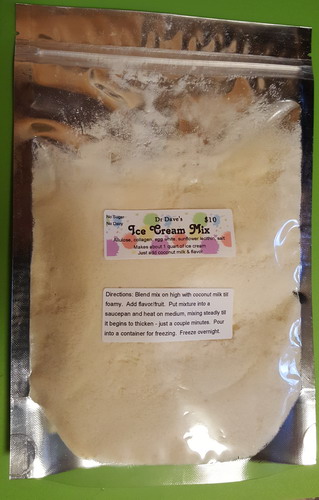 saucepan and gently heat the mixture while stirring constantly until
it just begins to thicken. Take off heat immediately and then pour everything into a container to put into your freezer. In 8 to 12 hours your personal flavor of dairy free sugar free ice cream will be ready to eat! Enjoy! Depending upon what flavors you put into the mix, this recipe makes about one quart of velvety rich ice cream.
saucepan and gently heat the mixture while stirring constantly until
it just begins to thicken. Take off heat immediately and then pour everything into a container to put into your freezer. In 8 to 12 hours your personal flavor of dairy free sugar free ice cream will be ready to eat! Enjoy! Depending upon what flavors you put into the mix, this recipe makes about one quart of velvety rich ice cream.
There are only 15 copies left of the Good Job Journal at the office. These journals counter the constant stream of negative criticism we get from  others and ourselves. Just a minute each day spent jotting down what you did well during
the day helps you to see yourself in a whole new light. We are better than we give ourselves credit for, but we don't see it because we have been taught to ignore the good and focus on the bad. Unfortunately this robs us of the confidence to tackle life with zest and enthusiasm. Get your self transformation tool now for only $10.
others and ourselves. Just a minute each day spent jotting down what you did well during
the day helps you to see yourself in a whole new light. We are better than we give ourselves credit for, but we don't see it because we have been taught to ignore the good and focus on the bad. Unfortunately this robs us of the confidence to tackle life with zest and enthusiasm. Get your self transformation tool now for only $10.
We have received a third batch of  copies of my book The Balanced Life. They are available in the office for $17.99, and they are also
available on Amazon.com
copies of my book The Balanced Life. They are available in the office for $17.99, and they are also
available on Amazon.com
Ellen update:
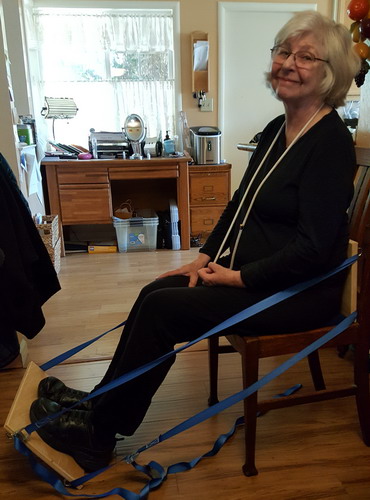
About a month ago I got the idea for a tool for building stronger bones in Ellen's hips. To combat osteoporosis you need to apply 3 to 4 times your body weight to the hip joint. I have seen pictures of special gym equipment for this purpose, which is very expensive. But when I considered what was actually happening, I decided there was an easy way to reproduce this action. The key is to place the
knee in a position that is only bent about 10 to 15%. At this point your leg has the greatest strength. The real world version of this is like when we try to push a stalled car by getting behind it an pushing with our legs. Here I have reproduced this with two boards and a couple tie-down straps. From this posture Ellen can push with her legs with quite a bit of pressure, which all gets translated up to her hip joints. Her balance is not good enough to allow her to
benefit from a rebounder, so this tool allows us a different way to build strength in her hips.
